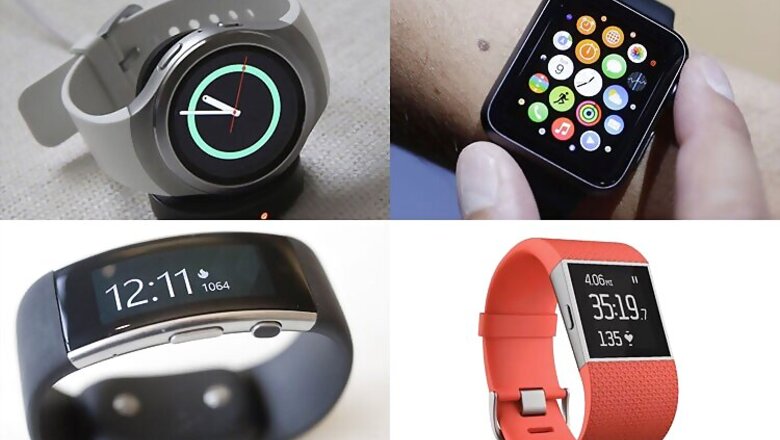
views
If you're looking for a device to track your fitness, alert you to incoming messages and occasionally let you buy stuff with a scan or a tap, there's no shortage of computerised wristwatches to choose from.
Over the past several months, I've tested numerous smartwatches for iPhones and Android devices, along with fitness trackers that have some smarts. I've even worn six watches at once during three marathons over the past month, courting both ridicule and some lousy times. (I'm blaming the extra weight.)
Smartwatches and fitness trackers are relatively early devices with a lot of growing up still to do. Temper your expectations, and you might be pleasantly surprised. Just don't go in expecting magic, because that's a recipe for disappointment.
Your options will vary depending on whether you use an iPhone or Android, as most of these watches require a companion phone for their smarts. There are also big differences between all-in-one smartwatches and simpler gadgets that primarily track fitness.
Smartwatches for Android:
Samsung's Gear S2 (starts at $300)
 Samsung Gear 2
Samsung Gear 2
Samsung smartwatches have improved tremendously. Instead of swiping through screen after screen, you now rotate the watch's circular outer ring to select apps or view notifications. The watch faces can display information ranging from stock quotes and headlines to sports scores. I tracked some Mets games that way, though the watch doesn't guarantee a win.
The main shortcoming: limited apps. The Gear S2 works with Android phones but doesn't run Android apps, putting it in a kind of limbo. A few apps from big-name partners like Yelp, The Wall Street Journal and Nokia's Here (for maps) are available, and Uber is coming soon. But most apps I looked for weren't there.
As for exercise, the watch mostly tracks footsteps and heart rate. Its mileage calculation is way off unless you're also carrying a phone with GPS. Alternatively, you could consider the Gear model with both GPS and 3G data for about $50 more, plus an additional $5 or $10 a month for the data plan.
The Gear S2 works with most Android phones, though some features specifically require a Samsung phone.
Android Wear (starts at $129)
 Asus ZenWatch 2
Asus ZenWatch 2
Several companies make smartwatches that run Google's Android Wear software. I tried the cheapest, Asus's ZenWatch 2, as a starting point. You can pay more for better bands, features such as built-in GPS or sheer luxury — right up to $1,500 for a model Tag Heuer developed with Intel and Google.
Android Wear has also gotten better. One swipe gets you apps, with recently used ones on top. Swipe again for contacts and again for common tasks. The screen can stay on without draining the battery, something rare in a smartwatch. App selection has also improved; many apps available for the Apple Watch now have Android Wear versions.
Sony's GPS-enabled SmartWatch 3 worked well for me while running, but other non-GPS devices, including the ZenWatch, were more frustrating. The main health app, Google Fit, doesn't let you start or stop workouts manually, with or without GPS. It relies on automatic detection and accused me of walking parts of my marathons, even though I didn't (really!). Several apps offer manual controls, but require built-in GPS or a phone, which can be a pain to carry on a run.
You need an Android phone for full functionality. Android Wear works with the iPhone, but it's handicapped. You don't get turn-by-turn navigation on the watch, for instance, as I learned the hard way driving to Toronto with a Moto 360.
Smartwatches for iPhones:
Apple Watch (starts at $349)
 Apple Watch
Apple Watch
Android Wear will work, but Apple Watch is the one you need for full functionality. Apple put a lot of thought into it, with the inclusion of a lefties mode and a passcode in case you leave it on a bathroom sink somewhere.
Apple Watch stands out in fitness. Although the watch doesn't have GPS, it learns your walking and running patterns when you have the phone with you, so it's more accurate than other non-GPS watches when you leave the phone at home.
Apple's smartwatch doesn't just count steps. Instead, it challenges — or nags — you to exercise at least 30 minutes a day and to take 12 walk breaks throughout the day. For a perfect score, you also need to burn a certain number of calories — determined by your age, sex, weight and fitness level. With rival devices, I meet my default goals easily. With Apple Watch, even an eight-mile morning run isn't enough. Bring on the challenge!
Apple Watch lacks advanced features found in sport-specific devices. I rely on a Garmin running watch during workouts, but Apple Watch nudges me the rest of the day.
Battery life isn't as good as Samsung and many Android Wear devices, though I made it through the recent marathons with plenty to spare by turning off the heart-rate monitor.
Fitness focused, for iPhone, Android or Windows:
Microsoft Band 2 and Fitbit Surge ($250 each)
 Microsoft Band 2
Microsoft Band 2
These are among the few fitness trackers with built-in GPS and heart-rate monitors. Don't confuse the Surge with cheaper Fitbit models, which mostly track footsteps. The Surge and the Band are limited smartwatches that can, for instance, notify you of new texts or calls. The Band also offers news headlines and a few apps from the likes of Starbucks and Facebook.
 FitBit Surge
FitBit Surge
But the Band's battery life doesn't cut it for heavy exercise. I outlasted the Band for all three 26.2-mile races. Even turning off the screen didn't keep it from dying before the finish, in one case just a third of a mile short. By contrast, the Surge lasted each race with plenty of charge to spare. Under normal use, the Surge lasts up to a week.
Both are solid fitness companions — at least for shorter workouts, in the case of the Band. But neither is a replacement for a sport-specific device.


















Comments
0 comment